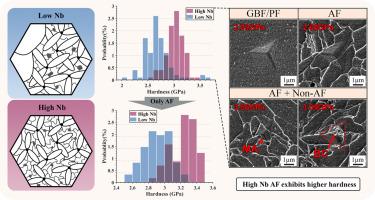Investigations on the effect of Nb on acicular ferrite dominant weld metal microstructure and toughness
IF 2.9
Q2 MATERIALS SCIENCE, MULTIDISCIPLINARY
引用次数: 0
Abstract
Despite the recognized benefits of Niobium (Nb) as a micro-alloying element in high-strength low-alloy (HSLA) steels, its adverse impact on weld metal toughness has been consistently observed and yet not fully understood. This study employs multiscale microstructural and properties characterization to investigate the effects of Nb on HSLA weld metal with a predominantly acicular ferrite (AF) microstructure. Based on nanoindentation results, the addition of Nb increases the hardness of AF phase in weld metal by 11.3 % - 13.1 % through solid solution strengthening, while exhibiting no significant enhancement in non-AF micro-constituents. In AF regions, Nb reduces the fraction of AF and promotes the formation of more equiaxed granular bainite (GB) by lowering the γ to α transformation temperature and inhibiting AF growth through a solute drag effect. Nb not only promotes the formation of low temperature transformation products such as martensite-austenite constituent (MA) and bainitic micro-constituent (BC) but also refines the distribution of MA within the microstructure. Analysis suggests the microstructural modifications associated with Nb cannot fully explain the toughness deterioration. The Nb-induced material strengthening, along with the intrinsic balance between strength and toughness in metallic materials, is likely the dominant factor in the reduction of toughness caused by Nb.

Nb对针状铁素体主导焊缝金属组织和韧性影响的研究
尽管人们认识到铌(Nb)作为高强度低合金(HSLA)钢中的微量合金元素的好处,但它对焊缝金属韧性的不利影响一直被观察到,但尚未完全了解。本研究采用多尺度显微组织和性能表征,研究Nb对针状铁素体(AF)为主组织的HSLA焊缝金属的影响。纳米压痕结果表明,Nb的加入通过固溶强化使焊缝金属AF相的硬度提高了11.3% ~ 13.1%,而非AF微组分的硬度没有显著提高。在AF区,Nb通过降低γ - α转变温度和抑制AF生长的溶质阻力效应,降低AF的含量,促进更等轴的粒状贝氏体(GB)的形成。Nb的加入不仅促进了马氏体-奥氏体成分(MA)和贝氏体微观成分(BC)等低温相变产物的形成,而且细化了MA在微观组织中的分布。分析表明,与Nb相关的显微组织变化不能完全解释韧性下降。Nb诱导的材料强化以及金属材料强度与韧性之间的内在平衡可能是Nb导致韧性降低的主要因素。
本文章由计算机程序翻译,如有差异,请以英文原文为准。
求助全文
约1分钟内获得全文
求助全文
来源期刊

Materialia
MATERIALS SCIENCE, MULTIDISCIPLINARY-
CiteScore
6.40
自引率
2.90%
发文量
345
审稿时长
36 days
期刊介绍:
Materialia is a multidisciplinary journal of materials science and engineering that publishes original peer-reviewed research articles. Articles in Materialia advance the understanding of the relationship between processing, structure, property, and function of materials.
Materialia publishes full-length research articles, review articles, and letters (short communications). In addition to receiving direct submissions, Materialia also accepts transfers from Acta Materialia, Inc. partner journals. Materialia offers authors the choice to publish on an open access model (with author fee), or on a subscription model (with no author fee).
 求助内容:
求助内容: 应助结果提醒方式:
应助结果提醒方式:


